|
|
|
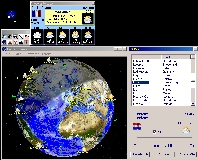
(c)
2001-2002
Lunar
Software Inc. Trial
version, registred $20
|
EarthBrowser   
This
small tool, 1.4 MB in size, conceals however a huge potential. It
gives you an intuitive view of weather and physical conditions on
the Earth. Using 3D modeling and a web connection, it displays the
last forecasts, earthquakes, volcanos and clouds coverage.
Images are created from real data and can be animated and rotate in
all directions. In-out zooms allow you to see the global change or
detail images of a selected area. The cloud coverage are updated
from satellites images each hour from synoptic measures and takes in
account the earth umbra path along the day and seasons.
In
option you can link to worldwide Webcams at the condition to
download the Quicktime 4 engine.
Now
at version 1.7, EarthBrowser
runs on all Windows 32-bits platforms. The trial version displays a lower resolution than the
registered package but gives satisfactory results for a casual user.
I
suggest to all editors of HF
propagation programs interested in low bands predictions to take
a look at this interface...

|
|
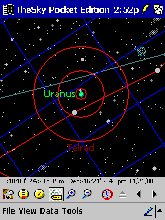
(c)
2001,
Bisque, $79
|
TheSky
Pocket Edition  
In
early 2001, Bisque released a
Pocket Edition of his famous TheSky
planetarium software for all Pocket PC (Palm, Cassiopeae, etc).
First
of all, bugs listed in Sky &
telescope test-report in the same time were resolved in the release 1.00.007 of TheSky
PE.
The main advantage of
this pocket planetarium
is that you can interface it with all scopes, from Celestron's
Ultima 2000, NexStar series, Meade's LX200 and Autostar, as well as
other systems using optical encoders (Tele Vue Sky Tour, Lumicon Sky
Vector, Orion Sky Wizard, etc...). You simply "Sync" your
Pocket PC, locate your DSO and you can use TheSky to slew the
telescope! A blessing if you are bored to use atlases in the field
to get an information about a celestial object : click on the DSO on
the screen instead of deciphering a five-digit designation in the
telescope's internal database
and all TheSky database is available at your fingertips.
Now
at version 1.00.007, TheSky
PE runs
on Windows CE platforms with 2.7 MB of RAM to display 15000 stars,
in addition to another 1.3 MB to run. The (almost) full SAO star catalog of
252000 stars (on 259000) requires installing another 4 MB RAM.
A
version "TheSky Pocket Edition" with "Pocket
TPoint" software" is also available ($129). This second
product helps you to drive a Paramount ME, AP-GTO, LX200, Autostar,
NexStar, Temma or other supported telescope. To complete this
set, SnoopSoft
provides a tool to customize your screen colors.
Test-reports
of this configuration are available to Sky &
Telescope. Have fun !

|
|
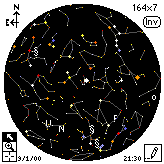
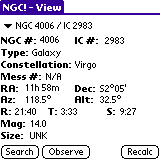
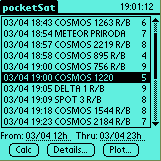
Portents
website
|
Palm
Pilot Tools   If
you are working or would like to use these electronic agenda, here
is one more reason to ask for one for your next birthday...
Searching astronomy programs I had the surprise to receive a mail
from my friend Briang Tung
listing dozen of applications immediately deliverable for the Palm's
serie, including his new PalmAtlas v1 programmed using the Unix tools (prc-tools and
pilrc).
This software available for Unix, PC and Mac OS is able to display
on any Palm Pilot 25,000 stars down to magnitude 7.5, with 32 bytes
per star with an extension to magnitude 9.0 for four circular
regions around the Pleiades, the Virgo cluster and the two celestial
poles. PalmAtlas v1 displays all Messier, NGC and IC DSO's too.
There are
also out there plenty of other astronomy programs, in
text or graphic mode suited for these small agenda, simulating the
night sky, the moon phases, the configuration of jovian satellites,
artificial satellite passes or calculating various ephemerides.
If
you are interested in getting a programming environment I suggest
you to look at Palmos,
which provides SDKs and developpment environments for Windows, MacOS
and Unix. Be sure to get MathLib
as this provides you the trig that you will want to avoid writing
yourself.
One
of the main sources of software is the Astronomical Computing
section of Sky & Telescope.
Their pages list programs written for the Pilot, PalmPilot or Palm
III and many other systems.
You
may also take a look at the amazing Marek Kozubal's Portents
collection of programs. His very complete and updated website lists some populars astronomy programs, with
features and
screenshots like the ones displayed at left, Star Pilot Plus, NGC and
PocketSat. Most of them can be downloaded in a feature-limited
version.

|
|
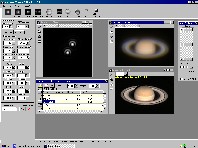

2001,
Cor
Berrevoets
Freeware
|
Aberrator  
Coincidence,
as I was asking on SAA forum for an application able to generate
images of stars as seen through telescopes (showing Airy-disc with
diffractions rings, PSF), Cor Berrevoets contacted me from The
Netherlands suggesting to look at his program, just released a few
days before.
His
freeware Aberrator displays static images showing the effects of
several types of aberrations (coma, astigmatism, spherical, coma,
tube-current, pinch, TDE) on scopes performances according their
aperture and their obstruction. Subjects processed are stars, double
stars or planets. You can also display the resulting image in B/W or color,
changing the focus, the wavelenghts and the focal shift.. These processes take in account the seeing
(turbulence) and are processed in a few seconds.
The
program is completed with a Point Spread Function (PSF), Modulation
Transfer Function (MTF) and PV/RMS wavefront images. This small but
powerful tool uses 2d-Fast Fourier Transform and is based on Harold
Suiter's book titled "Star testing Astronomical telescopes: a
manual for optical evaluation and adjustment" which will
complete this program.
The
program reads source files in JPG and exports star-test image in JPG format.
Now
at version 3, Aberrator
runs on most Windows platforms, from 95 to XP.

|
|
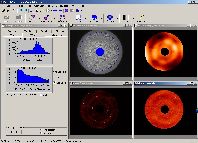

(c)
2001
Engineering
Synthesis Design
$4500
|
IntelliWave   
Raymond
Castonguay designed these last years IntelliWave, a
complex optical application that can be used with virtually any
static or phase shifted interferometer. The simpliest version of the
product, called LE-1 can easily acquire raw data from RS-170/CCIR
cameras or scanned images files saved in BMP, TIFF, JPG, PNG or EPS
formats. Once loaded the
raw datas are then processed to generate
surface data (phase) from one fringe frame and displayed in various
floating windows showing surface maps, diffractions patterns (FFT,
PSF, MTF) or interferograms.
All
controls are available from pull-down menus or directly from menus
icons. Other displays are under your control like the 3D plot of
surface map : you can select a colormap or a perspective view,
choose to display the profile of the surface according the position
of the mouse on the object or rotate it using some keystrokes. All plots are
completely customizable including colors, annotation, labeling,
scaling and resolution. These plots are completed by various
post-processing tools and computation of
surface statistics includes P-V, average, RMS and
Strehl ratio.
Of
course IntelliWave computes Zernikes and Seidels (all aberrations).
It can
be interfaced with Fizeau, Speckle, Twyman-Green, Holographic and
Moiré interferometers.
If
IntelliWave LE-1 presents a fringe resolution up to 800x600 pixels
on 8 bits,
version PE supports a resolution up to 4096x4096 pixels on 16 bits and Mega
Pixel cameras. Version PE can send data in
real-time to and from Excel, Research System's IDL and MatLab. PE
version also performs phase-shifted multi-interferogram data
acquisition and analysis which is much more accurate than
single-interferogram analysis.
Last
but not least it can use LabView to take interferometric data as a
function of any real-world parameter such as temperature, stress and
vibration.
Optionaly
the author provides a complete interferometric software library and
can provide drivers to support cameras such CIDTEC 2250 (512x512
pixels on 8 bits),
Kodak Mega Plus or any custom camera of your choice or even frames
grabbers. Unsupported devices request however a fee of $1500 to
develop the interface.
Now
at version 3.05, IntelliWave
print all statistical and
aberration data in a easily readable
format. It requests at least a 500 MHz CPU and any version of Windows
32-bit. It comes with a complete manual while the online help
provides all useful information with some dump screens. I only had
one DrWatson under NT although I used a PC with large resources. A
demonstration version requesting an authentication password is
available from the author's website. Only counterpoint, the price of
this product is as expensive as a large telescope... but Raymond
Castonguay offers 50% discounts to Educational Institutions and in
some situations donate the product to certain Educational
Institutions.

|
|
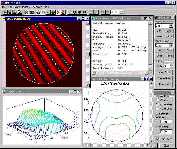
(c)
1999
Cyanogen, $1500
|
Quick
Fringe   
This
renowned optical software gathers all functions you need to test
telescope manufacturing or cross-checking large instruments (a few
meters aperture) at a competitive price.
This version is a major upgrade
providing more interfaces to frame grabber cards (ImageNation CX100,
FlashBus MV, VideoPort Pro), automatic fringe tracing, a
customizable printed test reports and help support. All data
measured with a laser can be converted in interferogram and
auto-traced, analyzed and displayed graphically through Quick
Fringe.
It
displays usual functions like 3D isometric plot, countour map, line
profile, synthetic interferogram, aberrations data and Zernike
Polynomials. Wavefront data includes RMS, P-V, Strehl ratio, Seidel
aberrations and more.
It
is completed with a manual fringe editor able to modify points, add
or delete fringe order or alter the aperture and obstruction.
The
program exports wavefront map and Zernike polynomials and reads BMP
and JPEG file formats. Now at version 4, it
runs on Windows 95, 98, NT and 2000.

|
|
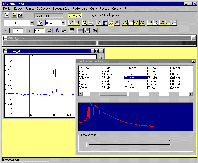
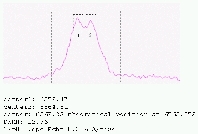
2000,
Valérie
Desnoux
Freeware
|
Visual
Spectrum   
Written
by Valérie
Desnoux,
VSpec is a tool dedicated to spectral study.
Spectral
imagery consists in reducing then analyzing the spectrum of an
object obtained by appropriate equipment, the spectroscop, usually
connected to a CCD device. The
image is then reduced to a spectral profile (graph) representing the
intensity of the spectrum by pixel.
Starting
from the spectral profile recorded by a CCD or scanned from a
negative, one carries out the analysis.
The first operation consists of calibrating the profile in
wavelength. VSpec provides an empirical reference spectra based only on
instrumentation parameters defined by the user.
To calculate the law of dispersion, VSpec assumes that the law is
linear. A database of wavelengths of natural elements is
available to help in identifying the lines. Another way of
calibrating the profile is to use atmospheric lines contained between 6875 and 7604
angstroms (H-alpha, water, oxygen) which lines are easily
recognizable. The user can then carry out various
operations of identification or correction like the identification
of the lines, modification of the spectral response, calculate the
absolute flux, normalizate the profile, correct the continuum,
calculate the Planck’s Law and last but not least measure the
center of the line, the equivalent width, the full width at
half-bandwidth and much more.
Without
speaking about its technical performance and very ergonomic
interface, Vspec comes with a
complete manual of 107 pages, a true cursus about spectroscopy fully
illustrated with various samples images, raw and calibrated.
VSpec
profile files can be exported in bitmap, ASCII or Excel format.
Among the tools available there are an animation function that
allows viewing of changes over time of a set of profiles or doing a
synthesis of the spectral image for comparison with the original.
Now
at version 1.4, VSpec
is available for all Windows platforms, in French or English version.
The minimum requirement is a 80486 CPU running Windows 95 with 8
MB RAM, an access to the Bight Star Catalog and MS-Excel to export
data. The support is however reduced to the strict minimum. It's a pity.

|
|

(c)
1994-2000
Manfred
Dings, 35 euros
|
Ephemeris
Tools 
This
tool written by a german amateur creates ephemeris tables Excel-compatible covering a wide range
of objects from the Sun and all nine planets to comets, asteroids,
artificial satellites and custom objects. This tool computes also
variable stars events, Jupiter and Saturn moon events as various
celestial phenomena (conjunction, eclipses, opposition, etc). The
response time is nearly instantaneous and you can also switch from high-performance methods to high-precision
methods without detecting the slightest slowing down.
Algorithms use the VSOP-theories for planets, ELP2000 for the moon,
NORAD TLP for artifical satellites and various others according the
object analysed. You
can request a numerical integration to compute asteroids and comets
parameters and to transform orbital elements into another epoch.
Depending of the calculation method used these modes are valid only
from 1900 to 2100 or 2200.
Once created, the program can edit or print all tables. It saves
data in CSV, XLS 4 or 5 and TXT format. At last you can also save your
configuration settings. However I deeply regret there is no
possibility to display graphically all these tables, excepting using
manually the graphics wizard of Excel; so much numbers give me an
indigestion. Now
at version 4.3, this
tool runs on Windows 95/98 and was successfully tested on Windows NT 4.0.

|
|
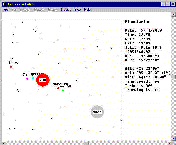
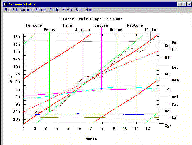
(c)
1995, Eric Bergman-Terrell, $15, Shareware
|
Astronomy
Lab 
This
new version includes much more graphs than the first one running
under Windows 3.1. This program displays different menus from report
to graphs and movies with an accuracy you will appreciate. All data
can be displayed after have entered the time (month/year) in tabular
way or using a more ergonomic graphical display.
The
Reports menu includes data on Seasons, dates of Easter, eclipses,
planets apsides, conjunctions and oppositions, Moon apsides and
nodes, main meteors showers, twilight and more.
The
Graphs menu displays X-Y sinusoids, including main planets
parametres (illumination, diameter, magnitude, rise/set, etc),
Jupiter moons orbits, the equation of time, analemma, etc.
The
Movies menu is more intuitive including a small planetarium, Jupiter
moons, a unusual simulation of binaries stars and more.
All
screens can be printed but data cannot be edited. Now at version 2,
the program runs on most Windows 32-bit platforms.
Contact
: Eric Bergman-Terrell, Personal MicroCosmos, 8547 E. Arapahoe Road,
Suite J-147, Greenwood Village, CO 80112, USA

|
|
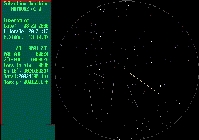
2000,
Sébastien
Gauthier
Freeware
|
Météore 
This
small but useful program written in French will help you to create a
database of all meteors observed during a night with their entry and
disapperance points. The program stores your local coordinates, the
timestamp of each event and gives you stats. At the end of the
session you can save datas in an ASCII log file and use it for
example in Excel.
Now
at version 1, it runs
under DOS or Windows 3.1 with a mouse. It was also successfully
tested on Windows 95 and NT 4.0.

|
|
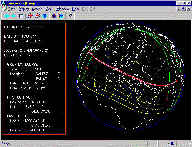
1999, S.Takesako
Freeware
|
Eclipse
Map  
An
excellent small japanese product dedicated to the Canon of solar
eclipses. Displaying the events on simple charts using a single
keystrocke you can quickly search for all solar eclipses from any
location. Another map displays the relative position of sun and moon
over the horizon.from any spot outside the eclipse area.

|
|

(c)
1996-98, Dr. Bruce P. Sidell
$20, Shareware
|
Moonrise 
Similar
to many other products (Astronomy Lab, AstroMeeus, Calenda, etc) I
particulary appreciate its display and tables.
To
complete the Moon phases calendar, it lists also the Moon ans Sun
rise, transit and set plus some others parameters. The Twilight Time
can be selected using the Astronomical, Nautical or Civil one. Some
more useful options are also provided on request (illumination,
Universal Time, etc).
Contact
: Dr. Bruce P. Sidell, 3115 Cascade SE, Grand Rapids, MI 49506, USA.

|
|
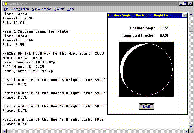
(c)
1989, Willmann-bell,
$15
|
AstroMeeus 
Published
by Willmann-Bell in 1989 this product is a software version of the
famous book titled "Astronomical Formulae for Calculator"
from the Belgian Jean Meeus, world expert in celestial mechanics. His numerous algorithms display tables
reports for the Sun, Moon and planets. It can also print a calendar
chart with Moon phases.

|
|

1998, COAA
Freeware
|
MessMara
A
small curiosity programmed
from an idea by Chris
Durman to forecast the best period to observe all Messier objects. The Observe menu of this freeware displays a
colorful 2D map showing the number of Messier Objects visible
each day of the year for your latitude. Another table displays the
list of Messier Objects you can see a specific night. A first step
in preparing the famous Messier marathon
(in French).

|
|
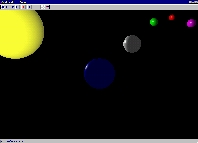
1996,
Henley
Quadling
Freeware
|
NBody
3D   
A
high-tech freeware which will amaze you when it will show you the
gravitational interactions of N-bodies in three dimensions. Seven
demo files are available from the binary system to a crazy model of
2 multiples systems containing 10 bodies in interaction. You can
customize the star radius, the angle of view, the central star color
and some other parameters like the speed. If your computer uses a
Pentium III 500 MHz CPU or higher you can try to improve the 3D
rendering too (up to 100 slices and stacks). Hours of fun !

|
|

1999,
ASSNE
Freeware
|
CCD 
A
small but useful tool to easily determine the characteristics of
your optical system when using a CCD. The program allow you to enter
new scopes and CCD cameras in its database. You first select a
configuration, a camera, a scope, the focal used (prime focus or
eyepiece projection). Then the program computes the effective pixel
size, chip coverage and some other parameters and present a
comparison between your CCD coverage and a 35mm film as well as the
size of various celestial object according your system
specifications.

|
|
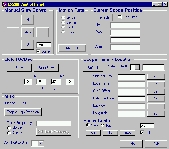
(c)1999, Steven
S.Tuma & Dean Williams, Registered |
LX
200 remote control panel (from Deep Sky 2000)  
Nothing
is more intuitive than using a Planetarium software to aim a
telescope with accuracy on stars and planets. This module included
in Deep Sky 2000 requires an ACP driver and is preset to drive a
LX200 mount and ETX's, ensuring high precision alignements and slow
motions. It can also drive a Celestron Nexstar or many other scopes
using a generic driver. On request other ACP drivers are available
from DC-3 Dreams Software.
This
program can be interfaced with Chris Marriott's SkyMap Pro 6 and
Sienna Software's Starry Night and even accepts vocal
"Goto" functions. The telescope must be connected using a
serial RS-232 port to the computer. All commands are driven from
this remote control panel.

|
Back
to Reports & Reviews
|